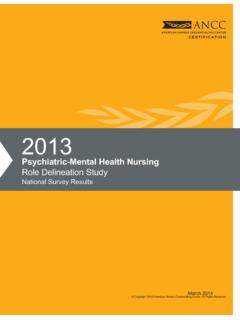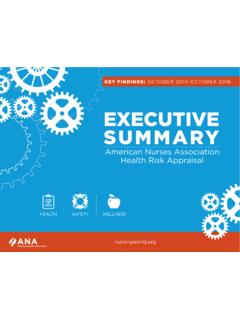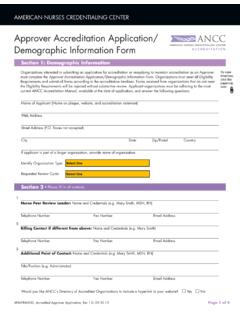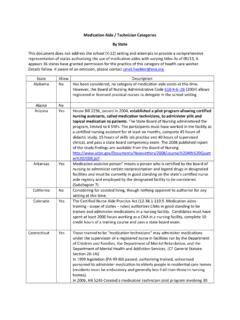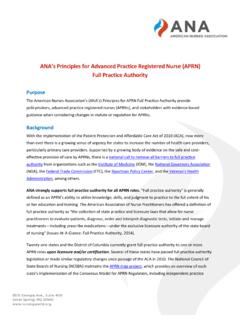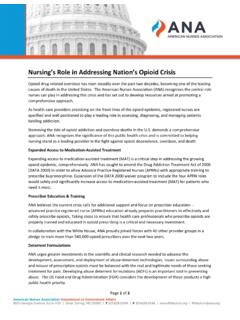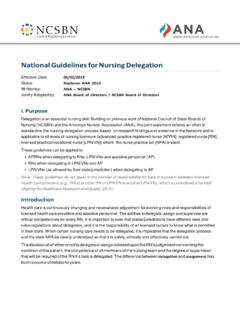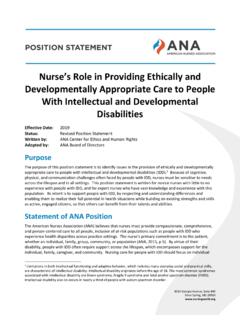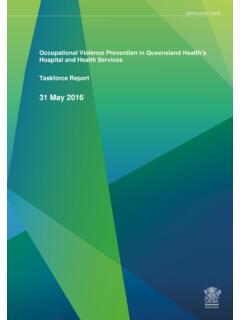Transcription of Reporting Incidents of Workplace Violence
1 8515 Georgia Avenue, Suite 400 Silver Spring, MD 20910 Reporting Incidents of Workplace Violence Effective Date: 2019 Overview The rate of Violence against health care workers has reached epidemic proportions. According to a 2012 report by the Government Accountability Office (GAO), health care workers in inpatient facilities experienced Workplace Violence -related injuries requiring days off from work at a rate at least five to 12 times higher than the rate of private-sector workers This type of Violence includes incidences of Violence against registered nurses (RNs) by patients, patients family members and external individuals, and it includes physical, sexual and psychological assaults. Workplace Violence has a demonstrable negative impact on the nursing profession and the overall health care Multiple studies have shown that Workplace Violence including other forms such as bullying and incivility as perpetrated by coworkers or supervisors can adversely affect the quality of patient care and care outcomes,iii contribute to the development of psychological conditions,iv and reduce the RN s level of job satisfaction and organizational , vi Moreover, the full scope of the problem is not fully known.
2 As the GAO report noted, Health care workers may not always report such Incidents , and there is limited research on the issue, among other reasons. In fact, research has variously found that only 20 to 60 percent of nurses report Incidents of , viii, ix That being said, in order to address a problem, building on the ANA position statement on incivility, bullying and Workplace Violence (ANA, 2015), one must first understand its full scope. Therefore, in addressing Workplace Violence against health care workers, RNs in particular, the reasons for underreporting Incidents of Violence must be identified and addressed. Because Workplace Violence events are difficult to substantiate with physical evidence, a systematic Reporting mechanism is warranted. Barriers to Reporting The literature identifies various barriers to Reporting incidences of Workplace Violence .
3 These barriers impact the ability not only of RNs but also of health care workers in general to report incidences of Workplace Violence and to address their root causes. They include the following: A health care culture that considers Workplace Violence part of the A perception that violent Incidents are A lack of agreement on definitions of Violence ; , does it include verbal harassment?xii 8515 Georgia Avenue, Suite 400 Silver Spring, MD 20910 Page | 2 Reporting Incidents of Violence Fear of being accused of inadequate performance or of being blamed for the incident, and fear of retaliation by the offender and or Lack of awareness of the Reporting A belief that Reporting will not change the current systems or decrease the potential for future Incidents of A belief that the incident was not serious enough to A practice of not Reporting unintentional Violence , , Incidents involving Alzheimer s Lack of manager and employer Lack of training related to Reporting and managing Workplace Violence .
4 A fear of Reporting supervisory Workplace These barriers together create significant disincentives for RNs to report Incidents of Workplace Violence . Removing these barriers requires a multifront strategy and the buy-in of both RNs and their employers. Creating a Culture That Supports Reporting The ANA has long supported voluntary Reporting of events, near misses and unsafe conditions through position statements like the one from 2010, Just Culture. xx In 2016, the ANA called for a culture of safety as the National Nurses Week theme. In the 2016 press release for National Nurses Week, Pamela M. Cipriano, PhD, RN, NEA-BC, FAAN explicitly tied worker safety and a culture of safety together when she described a culture of safety as one in which injuries to nurses and other health care professionals should not be tolerated as just part of the job.
5 Xxi Nurses are not alone in creating a culture of safety; leaders and managers from across the health care industry are called upon to take action in creating a culture of safety. In 2017, the American College of Healthcare Executives and the IHI/NPSF Lucian Leape Institute created a document, Leading a Culture of Safety: A Blueprint for Success, calling on health care executives to place safety as a core value that is fully embedded throughout our organizations and our industry. xxii The introduction states: By prioritizing, developing, and sustaining an organizational culture focused on safety, we can drive the future of healthcare to a place where patients and those who care for them are free from harm. It is not only one of many priorities, but is the overriding ethical imperative for all leaders. xxiii It is important as we move forward that we view nurse safety as part of the broader work of creating a culture of safety and recognize that there is support from the highest levels to address the cultural barriers listed above.
6 Reporting Process It bears noting that there is no standardized process or regulatory requirement except for a few states (n=9) that enacted Workplace Violence prevention and management legislation for health care workers to report Incidents of Violence in the much less a central repository to report them to (as seen in national health systems, , in the and Australiaxxv). Therefore, a health care worker who experiences an incident of Violence must follow the policies and procedures of his or her particular health care facility. 8515 Georgia Avenue, Suite 400 Silver Spring, MD 20910 Page | 3 Reporting Incidents of Violence This leads to a fragmented system where Incidents of Violence are reported differently at each health care facility and are not reported to any outside entity, limiting the ability of researchers to properly understand the scope and nature of the problem.
7 The Joint Commission considers assault a sentinel event. However, sentinel event reports are voluntary on the part of health care facilities, and this particular sentinel event appears to be vastly underreported; only 256 Incidents were reported from 1995 to In comparison, the Department of Labor estimated in 2011 that there are 22,250 to 80,710 Incidents of Violence against health care workers each In 2016, the Occupational Safety and Health Administration (OSHA) requested information from health care stakeholders on issues that might be considered in developing a regulation addressing Workplace Violence in health care settings. ANA submitted a comment letter to OSHA noting its support for a unified OSHA standard for Workplace Violence prevention programs. To date, there has been no movement on comments submitted in response to the request for information.
8 A 2014 update to OSHA s recordkeeping regulation requires all employers, including those in partially exempt industries, to report any work-related fatality to OSHA within eight hours of learning of the incident. The revised regulation also requires all employers to report work-related inpatient hospitalizations, amputations, and losses of an eye to OSHA within 24 hours of learning of the incident. (OSHA, 2015, ) These events can be reported to OSHA in person, by phone or by using the Reporting application on OSHA s public website at ANA Zero Tolerance Policy on Workplace Violence The 2015 ANA position statement Incivility, Bullying, and Workplace Violence professes a zero-tolerance policy on Violence of any kind: All RNs and employers in all settings, including practice, academia, and research, must collaborate to create a culture of respect that is free of incivility, bullying, and Workplace Violence .
9 Evidenced-based best practices must be implemented to prevent and mitigate incivility, bullying, and Workplace Violence ; to promote the health, safety, and wellness of RNs; and to ensure optimal outcomes across the healthcare continuum. ANA also recognizes the contribution of other health care professions and notes that this position statement is relevant to other health care professionals and stakeholders who collaborate to create and sustain a safe and healthy interprofessional work In order to adequately address the issue of Workplace Violence , it is critical that nurses, other health care professionals and their employers shift the professional and Workplace culture to adopt a mindset of zero tolerance toward Workplace Violence . Ambiguity on what constitutes Workplace Violence has proven to be a major impediment to Reporting such Incidents ; a uniform zero-tolerance policy diminishes those barriers and ensures that employees report all Incidents .
10 Only by following such a paradigm shift can nurses and employers begin to make impactful and long-lasting steps to reduce and ultimately end these incidences of Workplace Violence . 8515 Georgia Avenue, Suite 400 Silver Spring, MD 20910 Page | 4 Reporting Incidents of Violence recommendations ANA recommends a multifaceted strategy to combat the significant issue of Workplace Violence . The first component of this strategy is promoting and instilling a culture of zero tolerance toward Workplace Violence . This shift must be officially stated in all health care Workplace policies and procedures. No Workplace should tolerate any type of Violence against health care workers, including RNs. To this end, ANA recommends that OSHA establish a unified standard for employers in health care and social assistance settings to mitigate the frequency and severity of Workplace Violence ; ANA in April 2017 submitted a comment letter to OSHA on just such a standard.
